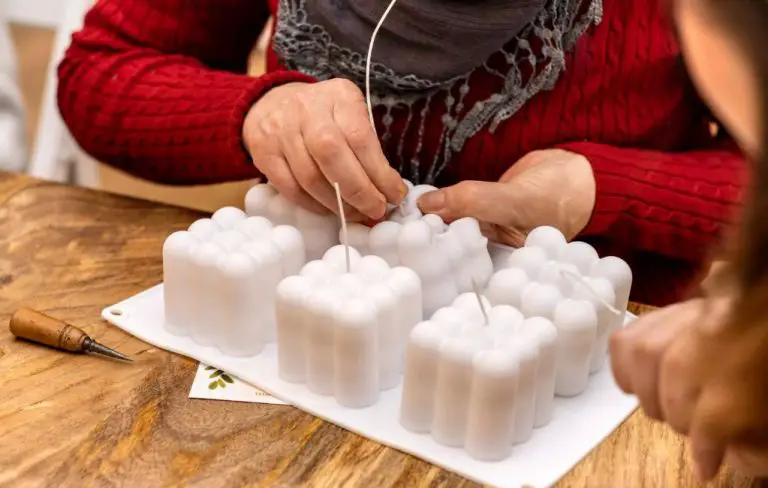How Much Fragrance Can Coconut Soy Wax Hold?
Coconut soy wax is a blend of natural vegetable wax derived from the oils of coconuts and soybeans. It is commonly used to make candles because it offers many benefits compared to paraffin wax. Coconut soy wax contains no paraffin, is biodegradable and made from sustainable crops (https://candlelore.com/blogs/news/coconut-soy-wax).
Coconut Soy Wax Overview
Coconut soy wax is a blend of coconut wax and soy wax that combines the benefits of both waxes. It has grown in popularity among candle makers and crafters due to its excellent performance and eco-friendly properties.
Some key benefits of coconut soy wax include:
- Clean burn – Coconut soy wax candles produce very little soot or smoke, resulting in cleaner air while the candle is burning (1).
- Minimal scent throw – The wax easily absorbs fragrance oils and provides excellent hot and cold scent throw (2).
- Smooth tops – Candles made with coconut soy wax self-level and create smooth, crater-free surfaces as they cool (3).
- Harder finish – The wax cures into a hard finish, resulting in long-lasting candles that retain their shape.
- Eco-friendly – Coconut soy wax is made from sustainable and renewable ingredients like coconut and soybean oils.
With its natural ingredients and excellent performance, it’s no wonder coconut soy wax has become a top choice for candle making and home fragrance projects.
Fragrance Load in Wax
The fragrance load refers to the maximum recommended amount of fragrance oil that a specific type of wax can hold before the properties and performance of the wax are negatively impacted. According to The Flaming Candle, the fragrance load is expressed as a percentage of the wax weight. For example, if a wax has a recommended fragrance load of 10%, that means for every 100 grams of wax, you should use no more than 10 grams of fragrance oil.
As explained by Fillmore Container, adding more fragrance oil than the recommended load can negatively impact the wax by making it too soft or causing it to lose its shape and structure. Exceeding the fragrance load percentage can also lead to issues like frosting, sweating, and oil sloughing in the finished candle.
Factors Affecting Fragrance Intensity
There are several key factors that determine how strong the fragrance will be in coconut soy wax:
Wax Type
The type of wax used makes a big difference. Coconut soy wax is very porous and absorbent, allowing it to hold more fragrance oil than paraffin wax. According to FragranceCalculator.com, coconut soy wax can hold 7-11% fragrance load, while paraffin wax holds 5-7%. The higher porosity and absorption of coconut soy wax enables it to retain and release more fragrance.
Fragrance Type

Some fragrance oils are naturally stronger than others. As the Serathena blog states, “The most fundamental thing that impacts the fragrance of a wax melt is the concentration of the oils that produce the scent.” Stronger fragrance oils with a higher concentration of aroma chemicals will produce a stronger scent. Floral and fruity fragrances also tend to be stronger than woody or earthy fragrances.
Temperature
Heating the wax to a higher temperature helps more fragrance oil get absorbed into the wax. However, overheating can burn off some of the scent chemicals. According to SoapQueen.com, the ideal temperature is 185-200°F to fully melt the wax while preserving the integrity of the fragrance oil.
Recommended Fragrance Load for Coconut Soy
The typical recommended fragrance load for coconut soy wax is 6-10% (1). However, some manufacturers state that coconut soy wax can hold up to 12% fragrance (2). The wax blend ratio also impacts fragrance load – a higher percentage of coconut oil allows for a higher fragrance load compared to higher soy content (3). Generally, a good starting point is 6-8% fragrance oil to wax.
Going above 10% fragrance load may result in fragrance throw issues like fading, burning off too quickly, scent changes, and oiliness on the wax surface. Anything below 6% may result in a candle with light fragrance (1, 3). Most candlemakers find the sweet spot is 8-10% for coconut soy wax.
Testing Fragrance Intensity
There are two main methods for testing fragrance intensity in coconut soy wax candles at home: the cure test and burn test.
The cure test involves pouring a small amount of wax into a container, adding fragrance at the target percentage, and allowing it to cure for 1-2 days. During this time, the fragrance will interact with the wax and you can evaluate the strength by smelling the wax. This gives a basic idea of projected scent throw. However, it doesn’t account for factors like wax pool size, wax melt pool temperature, and room size which also impact throw.
The burn test is considered more accurate. It involves making a complete candle, letting it cure properly, and then burning it in a realistic usage setting. As the candle burns, you can smell and rate the fragrance intensity in the room. Testing the same fragrance at different percentages provides comparative data. Industry experts recommend starting burn tests at 6% fragrance oil and adjusting up or down based on intensity. Proper burn testing evaluates wax type, fragrance percent, and wick specifications.
Both cure and burn testing help candle makers fine-tune recipes for ideal fragrance strength at home without lab equipment. Testing also provides knowledge that can be applied across multiple fragrance oils.
Adding More or Less Fragrance
Getting the right amount of fragrance oil in coconut soy wax is crucial for achieving your desired scent throw. Using too much or too little fragrance can significantly impact the performance and scent of the finished candle.
Adding too much fragrance oil, generally above 1.5 ounces per pound of wax, can lead to fragrance seepage or sweating. This is when the fragrance oil separates from the wax and leaks to the surface of the candle, causing oily spots or a greasy film (https://www.serathena.co.uk/blogs/home-fragrance-lifestyle-blog-uk/can-you-put-too-much-fragrance-oil-in-wax-melts). Too much fragrance may also prevent the wax from hardening properly, leading to soft spots.
Conversely, using too little fragrance, like less than .5 ounces per pound of wax, will result in a weak scent throw or no scent at all. The candle may not smell while burning or the scent will fade away quickly after being lit.
Testing out different fragrance loads between .5 to 1.5 ounces per pound of wax is recommended to find the right balance for each particular fragrance oil and coconut soy wax combination. Keeping detailed notes will help determine the optimal rates. Adjusting the amount of fragrance is key for coconut soy candles that smell perfectly scented without becoming overpowering.
Storing Highly Fragranced Wax
When wax contains a high fragrance load, proper storage is important for maintaining scent intensity over time. According to this source, the ideal storage conditions for highly fragranced wax are in a cool, dry location away from direct sunlight and heat. Heat and light can cause the fragrance oils to evaporate more quickly. Storing wax in a dark, room temperature area will help preserve the scent.
Storing wax melts in an airtight container is also recommended to prevent fragrance loss, as exposed to air the oils can oxidize and fade faster. Glass jars or metal tins with tight lids are good options for storage. Only open the container when necessary to limit air exposure. With proper storage methods, the fragrance in wax with a high load should remain robust for many months.
Fragrance Oils for Coconut Soy Wax
When selecting fragrance oils for coconut soy wax, some of the best options include:
Fruity scents like coconut, pineapple, mango, and citrus. The sweet fruity notes pair well with the natural coconut scent in the wax.
Vanilla, caramel, and other warm dessert fragrances. These gourmand scents complement the subtle coconut notes.
Lighter floral fragrances like jasmine, rose, or lilac. The florals create an inviting spring/summer aroma.
Woodsy fragrances like sandalwood, cedarwood, and pine. These pair with coconut’s subtle woodsy undertones.
Avoid heavy musk or spice fragrances as they may overwhelm the light coconut scent. Stick to lighter fruity, floral, or woodsy options for best results.
Conclusion
Coconut soy wax is usually able to hold around 5-6% oil fragrance, though the exact amount can vary based on factors like the individual fragrance, wax quality, and desired intensity. When testing new fragrances, start with a 5% load and evaluate the scent throw to determine if more or less is needed. The wax will generally hold scent nicely when proper practices are followed, like fully incorporating the fragrance and avoiding extremely hot pour temps. With the right fragrance oils, coconut soy can release beautiful aromas for products like candles and melts.
In summary, the typical fragrance load capacity for coconut soy is around 5-6% of the wax weight. But working with lower or higher amounts is common depending on your specific needs and preferences.






